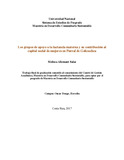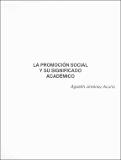| dc.contributor.advisor | Bonilla Céspedes, Marvin | |
| dc.contributor.advisor | Fonseca Carballo, Jonathan | |
| dc.contributor.author | Castro Hernández, Nicole Dayana | |
| dc.contributor.author | Moya Rojas, Katherine Pamela | |
| dc.contributor.author | Villalobos Cabezas, Marco Andrés | |
| dc.date.accessioned | 2021-09-09T14:29:48Z | |
| dc.date.available | 2021-09-09T14:29:48Z | |
| dc.date.issued | 2021-08 | |
| dc.identifier.uri | http://hdl.handle.net/11056/21102 | |
| dc.description.abstract | El presente proyecto de investigación trata sobre “Representaciones sociales del territorio desde los Estudios Sociales, a través de la cartografía social, durante el año 2020 al 2021 en las poblaciones del distrito central de Tilarán y distrito de San Francisco de Heredia.” El mismo se enmarca en la investigación socioeducativa y parte de la Licenciatura en la Enseñanza de los Estudios Sociales y la Educación Cívica, bajo la modalidad de Seminario de Graduación. Este presenta por eje de investigación: Los Estudios Sociales y La Educación Cívica para el Nuevo Milenio, desafíos desde una Perspectiva crítica, respondiendo al problema de investigación: ¿cómo los Estudios Sociales promueven las habilidades del pensamiento geográfico a partir de las representaciones sociales de territorio en la población de los distritos Central de Tilarán y San Francisco de Heredia? Se sustenta, teóricamente en tres grandes categorías de análisis: representaciones sociales, territorio y pensamiento geográfico, las cuáles engloban de manera integral las conceptualizaciones básicas para el estudio a fin. Metodológicamente, parte del paradigma naturalista humanista, enfoque cualitativo, diseño de Investigación fenomenológico y tipo de estudio descriptivo.
En la aplicación de instrumentos para la recolección de información se utilizó: análisis bibliográfico, observaciones no participativas y grupo de discusión plasmado como taller con la comunidad docente desde la cartografía social. Así como entrevistas semiestructuradas a comunidad social y docente, encuestas tipo cuestionario. En última instancia, para el contraste de la información se utiliza la triangulación de datos
De esta manera, se logró, identificar las representaciones sociales del territorio que poseen las comunidades sociales y docentes participantes, por medio de la cartografía social aplicada y puesta en acción a la comunidad docente de Estudios Sociales que apoyó, así como, examinar la percepción que engloban las habilidades del pensamiento geográfico. | es_ES |
| dc.description.abstract | This research project deals with "Social representations of the territory from Social Studies, through social cartography, during the year 2020 to 2021 in the towns of the central district of Tilarán and the district of San Francisco de Heredia." It is part of the socio-educational research and part of the Bachelor's Degree in Teaching Social Studies and Civic Education, under the modality of Graduation Seminar. This presents by research axis: Social Studies and Civic Education for the New Millennium, challenges from a critical perspective, responding to the research problem: how does Social Studies promote the skills of geographic thinking from the social representations of territory in the population of the Central de Tilarán and San Francisco de Heredia districts? It is based, theoretically, on three major categories of analysis: social representations, territory, and geographical thought, which comprehensively encompass the basic conceptualizations for the study at hand. Methodologically, part of the humanist naturalist paradigm, qualitative approach, phenomenological research design and type of descriptive study. In the application of instruments for the collection of information, the following were used: bibliographic analysis, non-participatory observations, and a discussion group embodied as a workshop with the teaching community from social cartography. As well as semi-structured interviews to the social and educational community, questionnaire-type surveys. Ultimately, to contrast the information, data triangulation is used.In this way, it was possible to identify the social representations of the territory that the participating social communities and teachers have, through social cartography applied and put into action to the Social Studies teaching community that supported, as well as, examine the perception that encompasses geographic thinking skills. | es_ES |
| dc.description.sponsorship | Universidad Nacional, Costa Rica | es_ES |
| dc.language.iso | spa | es_ES |
| dc.publisher | Universidad Nacional, Costa Rica | es_ES |
| dc.rights | Acceso abierto | es_ES |
| dc.rights.uri | http://creativecommons.org/licenses/by-nc-sa/4.0/ | * |
| dc.subject | TEORIA DE LAS REPRESENTACIONES SOCIALES | es_ES |
| dc.subject | ESTUDIOS SOCIALES | es_ES |
| dc.subject | COMUNIDAD | es_ES |
| dc.subject | THEORY OF SOCIAL REPRESENTATIONS | es_ES |
| dc.subject | SOCIAL STUDIES | es_ES |
| dc.subject | COMMUNITY | es_ES |
| dc.title | Representaciones sociales del territorio desde los Estudios Sociales, a través de la cartografía social, durante el año 2020 al 2021 en las poblaciones del distrito central de Tilarán y distrito de San Francisco de Heredia | es_ES |
| dc.type | http://purl.org/coar/resource_type/c_7a1f | es_ES |
| dc.description.procedence | Escuela de Historia | es_ES |



